Developing and Evaluating a Digital Pathology Platform for Veterinary Students: A Case Study in Romania
Simple Summary
Abstract
1. Introduction
2. Materials and Methods
2.1. Digital Slide Acquisition
2.2. Storage System Development
2.2.1. Central Storage
2.2.2. Database Implementation
2.2.3. API and Web Interface
2.2.4. Web Server and Security
2.2.5. Network Configuration
2.2.6. Access and User Management
2.3. Data Preparation
2.4. Statistical Analysis
2.4.1. Descriptive Statistics
2.4.2. Inferential Statistics
2.5. Practical Session Structure
3. Results
3.1. Questionnaire I Results
3.1.1. Preferred Study Methods—Question I.1
3.1.2. Perceived Usefulness of Methods—Questions I.2 to I.5
3.1.3. Comparing the Analysis Results of the First Question with the Likert Scale
3.2. Questionnaire II Results
- Improves the overall learning process.
- Specifically improves the students’ self-review process.
- Specifically improves the reviewing knowledge.
- Accessibility/ease of use.
- Students compare and praise the quality of the digital slides images to their own photos taken from in-lab microscope access.
- Students highlight the modern style of learning and the digital aspect of the platform.
- Students praise the quality of the images and the ability to zoom in.
4. Discussion
4.1. Learning Resources and Student Preference
4.2. Student Expectations and Feedback on the DSP
4.3. Implementation and Cost-Effectiveness of Digital Pathology
4.4. Additional Benefits and Applications of Slide Scanners
4.5. Context of Digital Technology in Romania
4.6. Limitations and Future Prospects
5. Conclusions
Supplementary Materials
Author Contributions
Funding
Institutional Review Board Statement
Informed Consent Statement
Data Availability Statement
Acknowledgments
Conflicts of Interest
Correction Statement
References
- Holmes, M.A.; Nicholls, P.K. Computer-Aided Veterinary Learning at the University of Cambridge. Vet. Rec. 1996, 138, 199–203. [Google Scholar] [CrossRef]
- Chernikova, O.; Heitzmann, N.; Stadler, M.; Holzberger, D.; Seidel, T.; Fischer, F. Simulation-Based Learning in Higher Education: A Meta-Analysis. Rev. Educ. Res. 2020, 90, 499–541. [Google Scholar] [CrossRef]
- Kefalis, C.; Skordoulis, C.; Drigas, A. Digital Simulations in STEM Education: Insights from Recent Empirical Studies, a Systematic Review. Encyclopedia 2025, 5, 10. [Google Scholar] [CrossRef]
- Tsang, H.C.; Morse, R.J.; Zhang, J.; Bui, T.; Emrich, B.; Hasan, R.A.; Lieberman, J.A. The Clinical Pathology Laboratory in 360° Virtual Reality. Am. J. Clin. Pathol. 2025, 163, 936–946. [Google Scholar] [CrossRef] [PubMed]
- Haleem, A.; Javaid, M.; Qadri, M.A.; Suman, R. Understanding the Role of Digital Technologies in Education: A Review. Sustain. Oper. Comput. 2022, 3, 275–285. [Google Scholar] [CrossRef]
- Ancheta, K.; Le Calvez, S.; Williams, J. The Digital Revolution in Veterinary Pathology. J. Comp. Pathol. 2024, 214, 19–31. [Google Scholar] [CrossRef]
- Jones-Hall, Y.L.; Skelton, J.M.; Adams, L.G. Implementing Digital Pathology into Veterinary Academics and Research. J. Vet. Med. Educ. 2022, 49, 547–555. [Google Scholar] [CrossRef]
- Vyas, M. Traditional Learning Students Insights. J. Pharm. Negat. Results 2023, 13, 3986–3995. [Google Scholar]
- Pop, A.; Predoi, G.; Andronie, V. Interactive E-Learning for Veterinary Medicine Students and Practitioners. Sci. Work. Ser. C. Vet. Med. 2013, 59, 131–134. [Google Scholar]
- Ştefan, A.E.; Musat, S.; Gologan, D.; Sanda, A.C.; Rizac, R.; Militaru, M. Educational Tissue Arrays for Veterinary Medicine. Rev. Română Med. Vet. 2023, 33, 36–40. [Google Scholar]
- Bărăităreanu, S.; Brozbă, G.A.; Militaru, M. The Concept of Quality in Veterinary Education and the Quality Culture Development: A Brief Review. Rev. Romana Med. Vet. 2019, 29, 57–62. [Google Scholar]
- Dobre, I.R.; Dobre, S.O. Effective Teaching-Learning Methods and Techniques Applicable to Veterinary Medical Practice. Rev. Romana Med. Vet. 2012, 58, 271–276. [Google Scholar]
- Militaru, M.; Furnaris, M.M.; Craciun, M.M.; Mustatea, A.I.; Goran, G.V.; Baillie, S. The Perception of the Concept of Communication Between Teacher and Student in Veterinary Education. Rev. Română Med. Vet. 2020, 30, 35–43. [Google Scholar]
- Furnaris, M.M.; Şarpe, M.C.; Chiracu, A.; Bărăităreanu, S.; Militaru, M. Perception of Students and Teachers in the Faculty of Veterinary Medicine towards Online Communication. Rev. Romana Med. Vet. 2020, 30, 49–60. [Google Scholar]
- Schoenfeld-Tacher, R.M.; McConnell, S.L.; Schultheiss, P.C.; Schultheiss, T. Use of Interactive Online Histopathology Modules at Different Stages of a Veterinary Program. J. Vet. Med. Educ. 2003, 30, 364–371. [Google Scholar] [CrossRef] [PubMed]
- Rigaut, J.P. An Empirical Formulation Relating Boundary Lengths to Resolution in Specimens Showing ‘Non-ideally Fractal’ Dimensions. J. Microsc. 1984, 133, 41–54. [Google Scholar] [CrossRef]
- Silage, D.A.; Gil, J. Digital Image Tiles: A Method for the Processing of Large Sections. J. Microsc. 1985, 138, 221–227. [Google Scholar] [CrossRef]
- Aeffner, F.; Adissu, H.A.; Boyle, M.C.; Cardiff, R.D.; Hagendorn, E.; Hoenerhoff, M.J.; Klopfleisch, R.; Newbigging, S.; Schaudien, D.; Turner, O.; et al. Digital Microscopy, Image Analysis, and Virtual Slide Repository. ILAR J. 2018, 59, 66–79. [Google Scholar] [CrossRef]
- Malarkey, D.E.; Willson, G.A.; Willson, C.J.; Adams, E.T.; Olson, G.R.; Witt, W.M.; Elmore, S.A.; Hardisty, J.F.; Boyle, M.C.; Crabbs, T.A.; et al. Utilizing Whole Slide Images for Pathology Peer Review and Working Groups. Toxicol. Pathol. 2015, 43, 1149–1157. [Google Scholar] [CrossRef]
- Kanahashi, T.; Yamada, M.; Ibuki, K.; Takakuwa, T. Construction of a Preliminary Digital Parasite Specimen Database for Parasitology Education and Research. Sci. Rep. 2025, 15, 20711. [Google Scholar] [CrossRef]
- Butcaru, A.C.; Dumitrașcu, D.I.; Mihai, C.A.; Stănică, F. A Digital System to Monitor the Canopy in Some Apple and Quince Cultivars. Sci. Papers. Ser. B. Hortic. 2023, 67, 45–52. [Google Scholar]
- Myslyva, T.; Dasai, M.; Huisden, C.M.; Nadtochiy, P.; Bilyavskyi, Y. Application of Machine Learning Approaches for Land Use Change Modelling in Suriname. Sci. Papers. Ser. E. Land Reclam. Earth Obs. Surv. Environ. Eng. 2024, XIII, 830–840. [Google Scholar]
- Puchianu, D.C. Waste Classification Using Efficient Neural Networks and Web Application. Sci. Papers. Ser. E. Land Reclam. Earth Obs. Surv. Environ. Eng. 2024, XIII, 226–233. [Google Scholar]
- Muraru, S.L.; Cardei, P.; Muraru, V.; Sfîru, R.; Condruz, P.; Muraru-Ionel, C. “Open Innovation Ecosystem 2.0” Digital Platform for Agriculture, Forestry and Food Industry. Sci. Papers. Ser. A. Agron. 2022, LXV, 666–671. [Google Scholar]
- Toma, R.C.; Mărgărit, G.L.; Constantinescu-Gropoșilă, D.; Barba, D.; Popa, G. The Use of Mobile Applications in the Field of Biotechnologies. Sci. Bulletin. Ser. F. Biotechnol. 2018, 22, 233–236. [Google Scholar]
- Toma, R.C.; Mărgărit, G.; Constantinescu-Gropoşilă, D.; Barba, D.; Popa, G. eBIODEX: A Useful Mobile Tool in the Field of Biotechnology e-Learning Ecosystem. Sci. Bulletin. Ser. F. Biotechnol. 2020, 24, 206–210. [Google Scholar]
- Bozkurt, Y.; Mikail, N.; Uluşar, Ü.D.; Aktaş, H.; Dogan, C. Prediction of Bodyweight of Holstein and Brown-Swiss Male Cattle by Using Digital Images. Sci. Papers. Ser. D. Anim. Sci. 2017, LX, 196–201. [Google Scholar]
- Sala, F.; Boldea, M.; Gergen, I. Fractal Characterization of Wheat Crop Based on Digital Images Captured in the Visible Spectrum. AgroLife Sci. J. 2014, 3. [Google Scholar]
- Home-Virtual Microscopy 3.0. Available online: https://vm.projects.umfiasi.ro/index.php (accessed on 29 June 2025).
- DPA: Digital Pathology Association. Available online: https://digitalpathologyassociation.org/ (accessed on 29 June 2025).
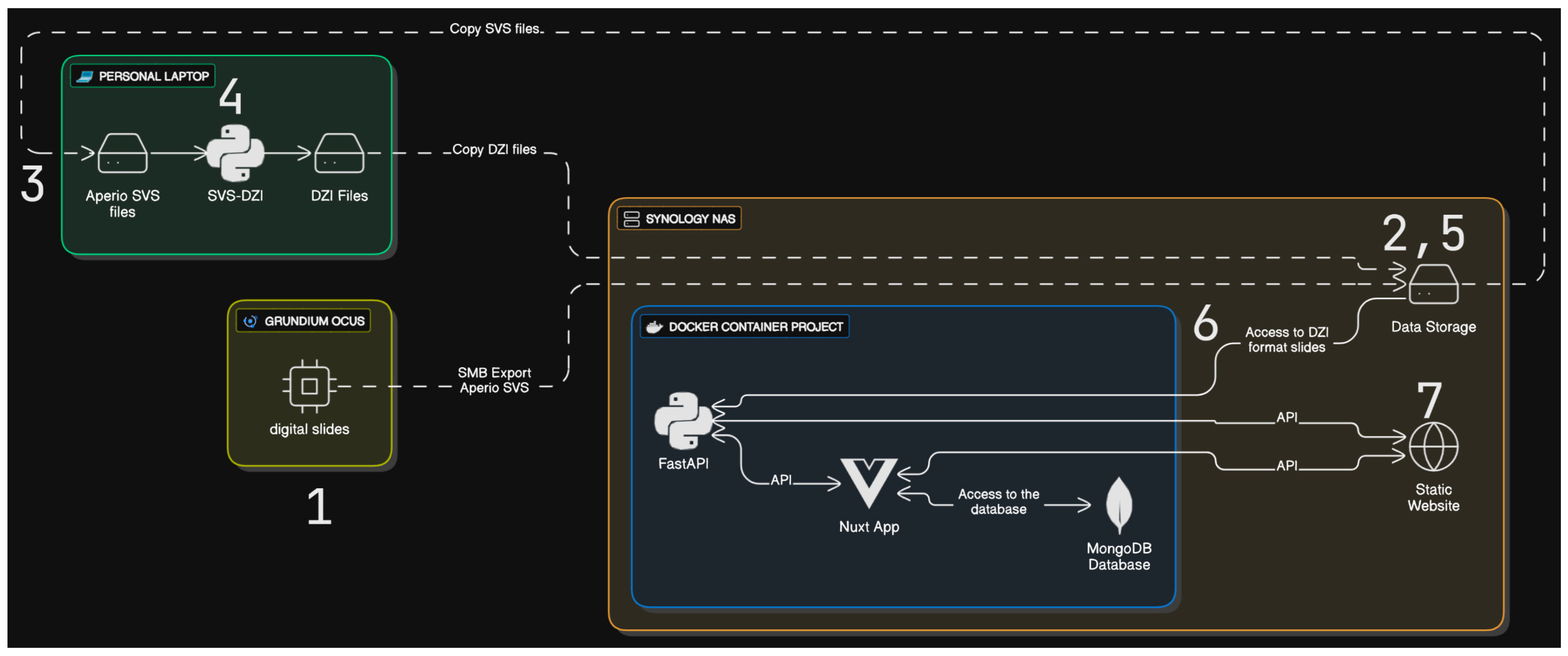
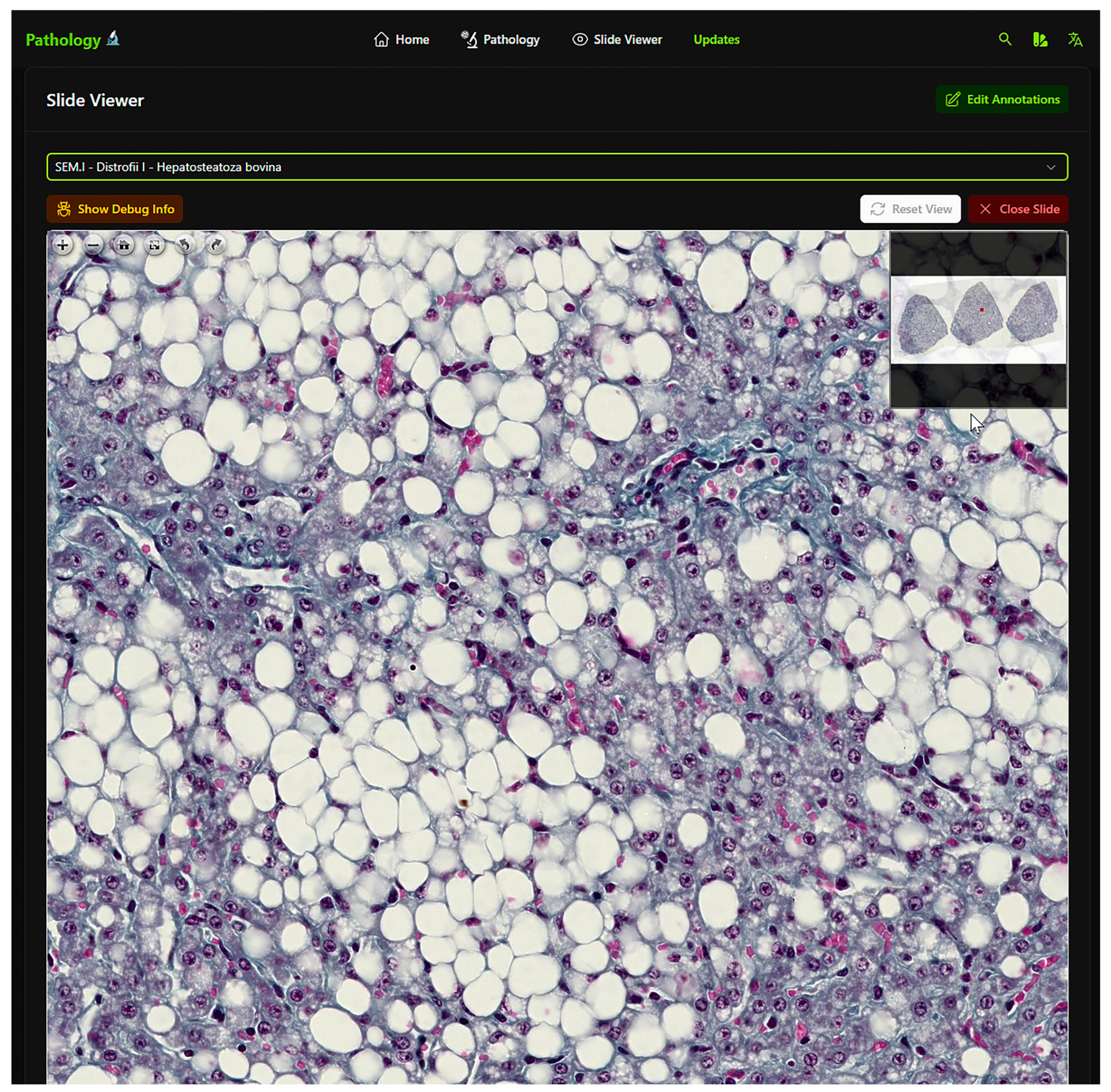
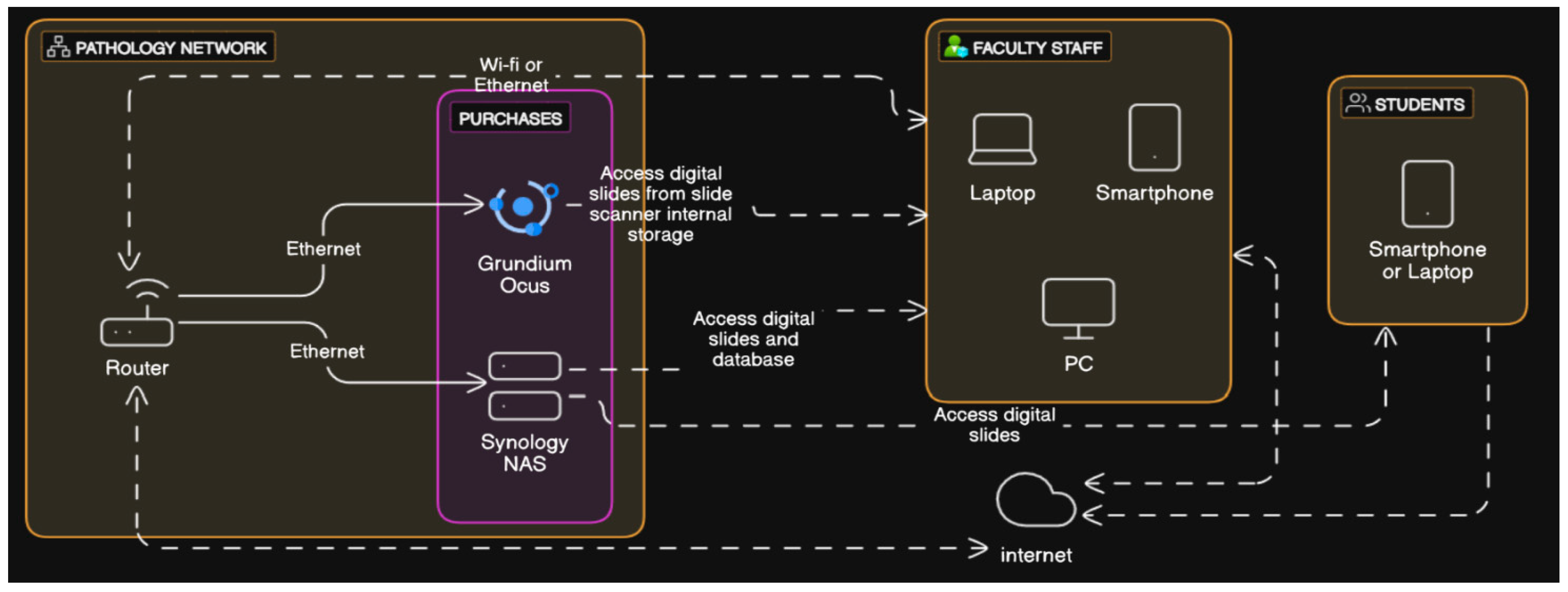
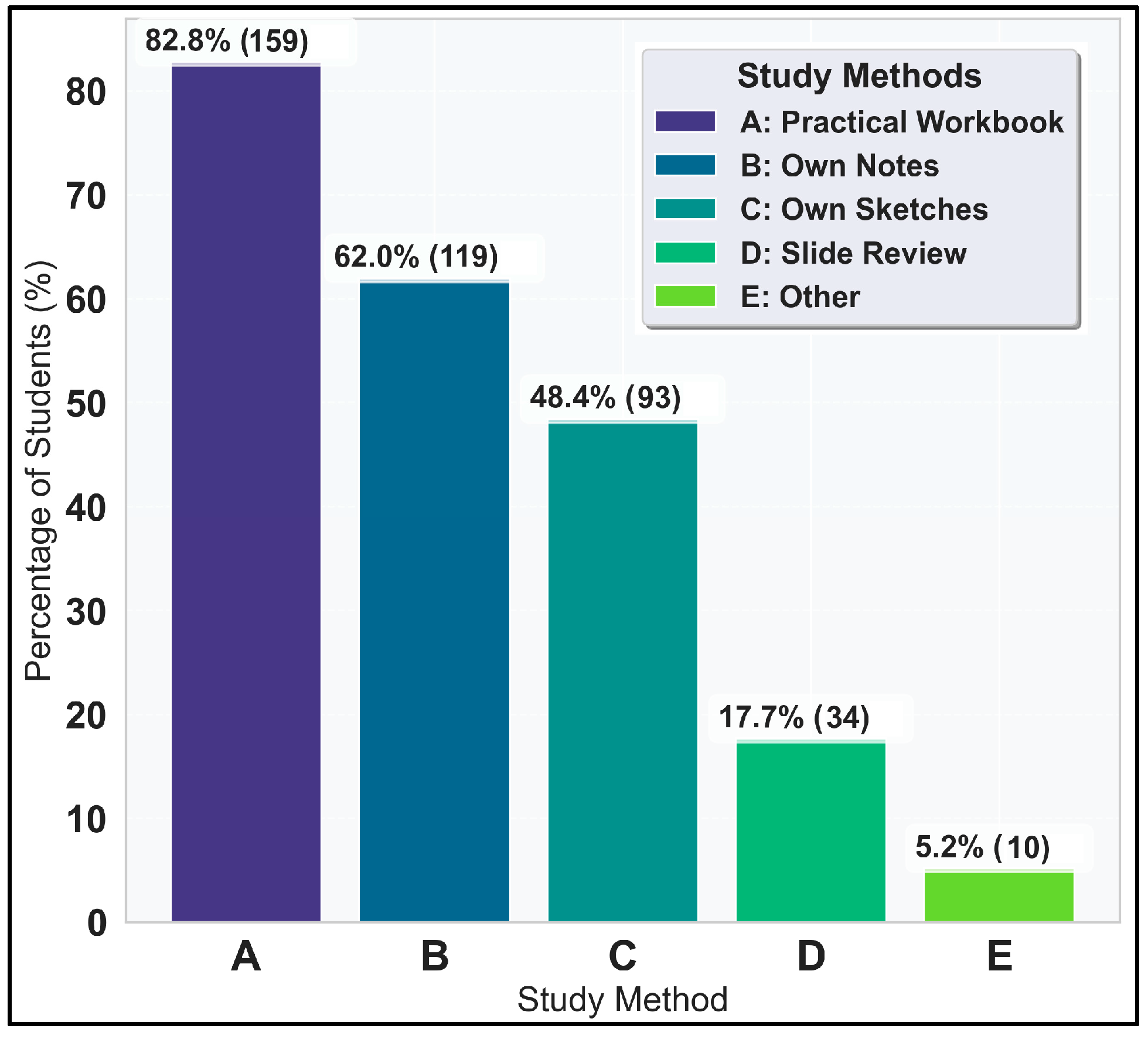
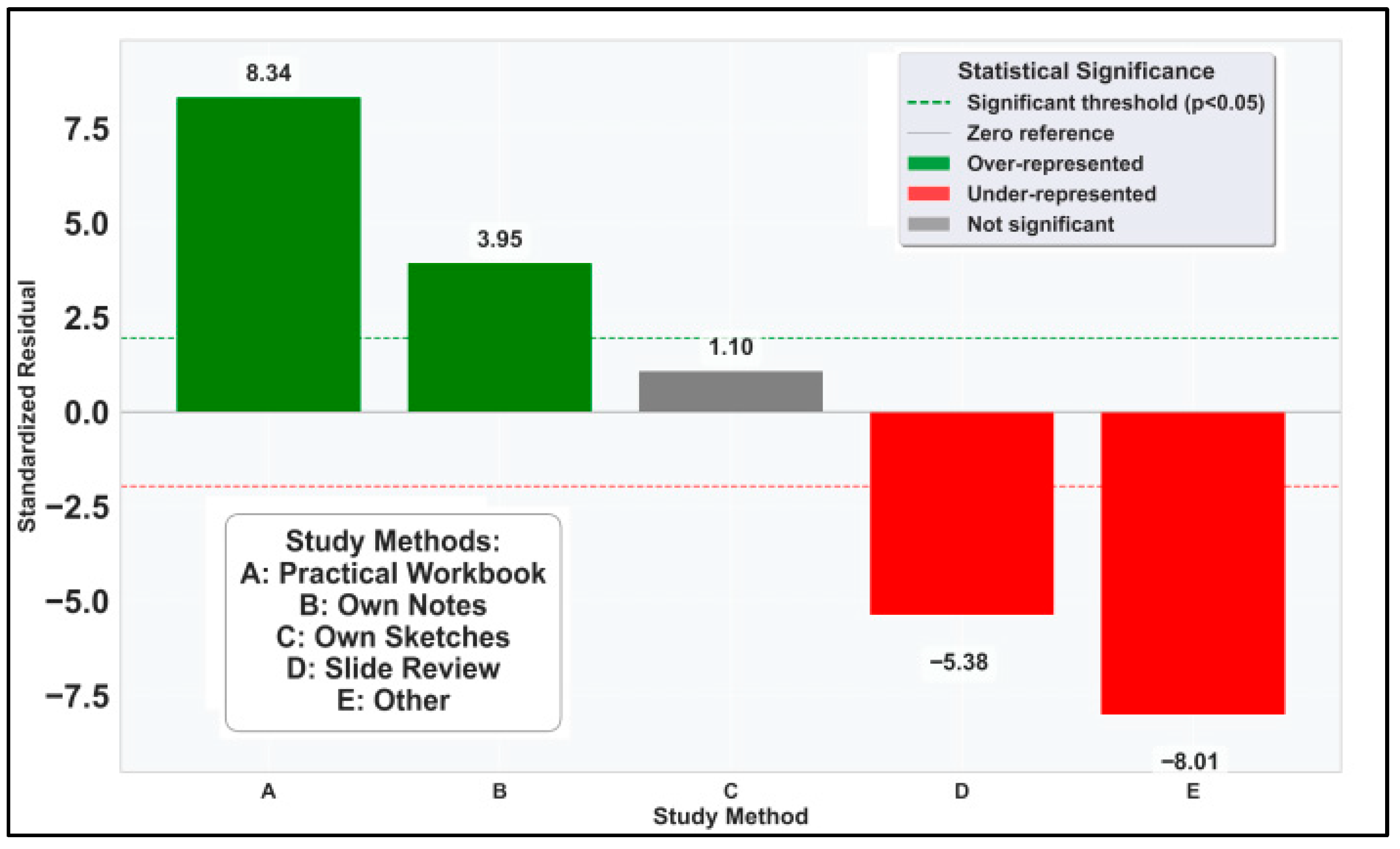
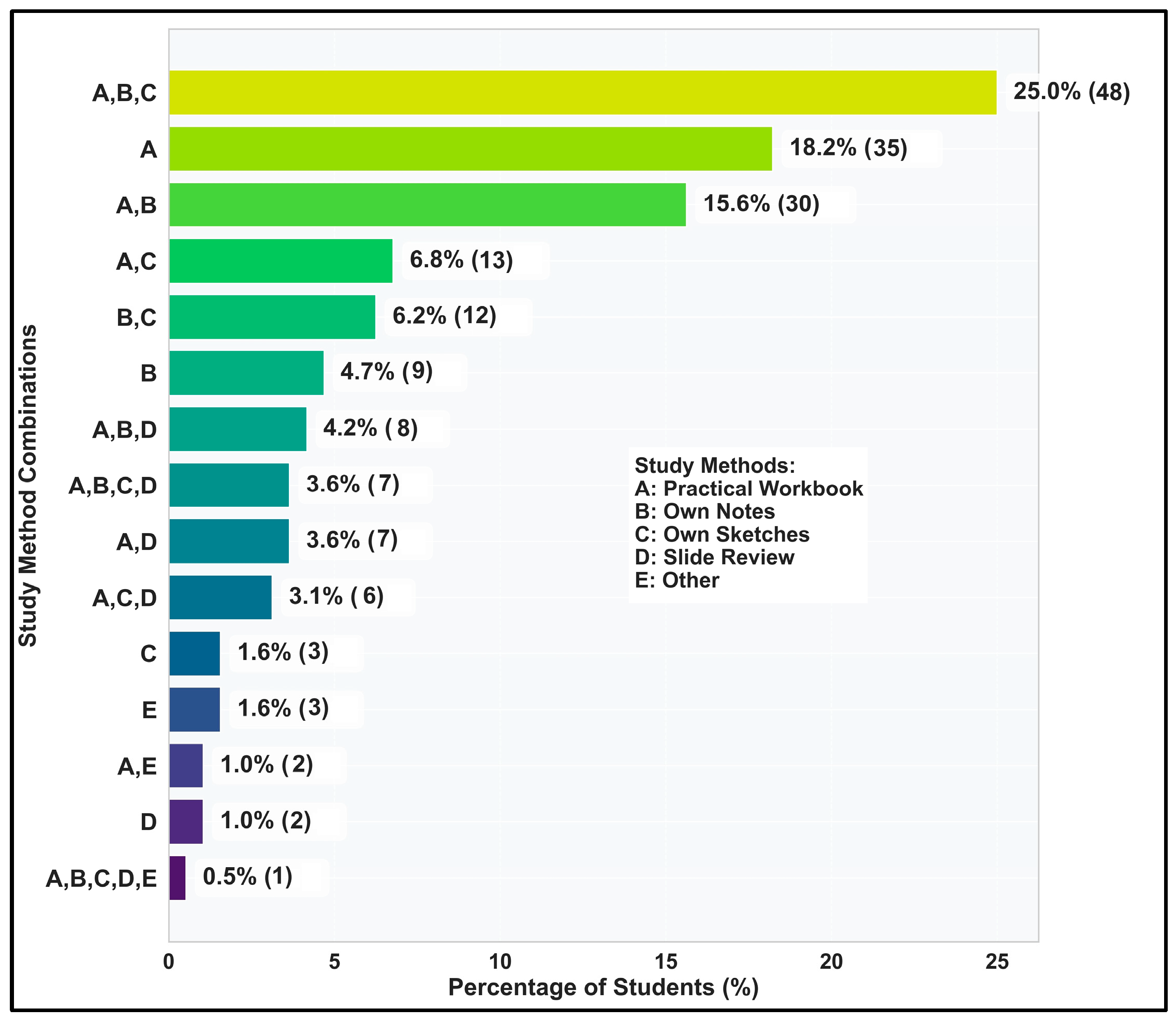
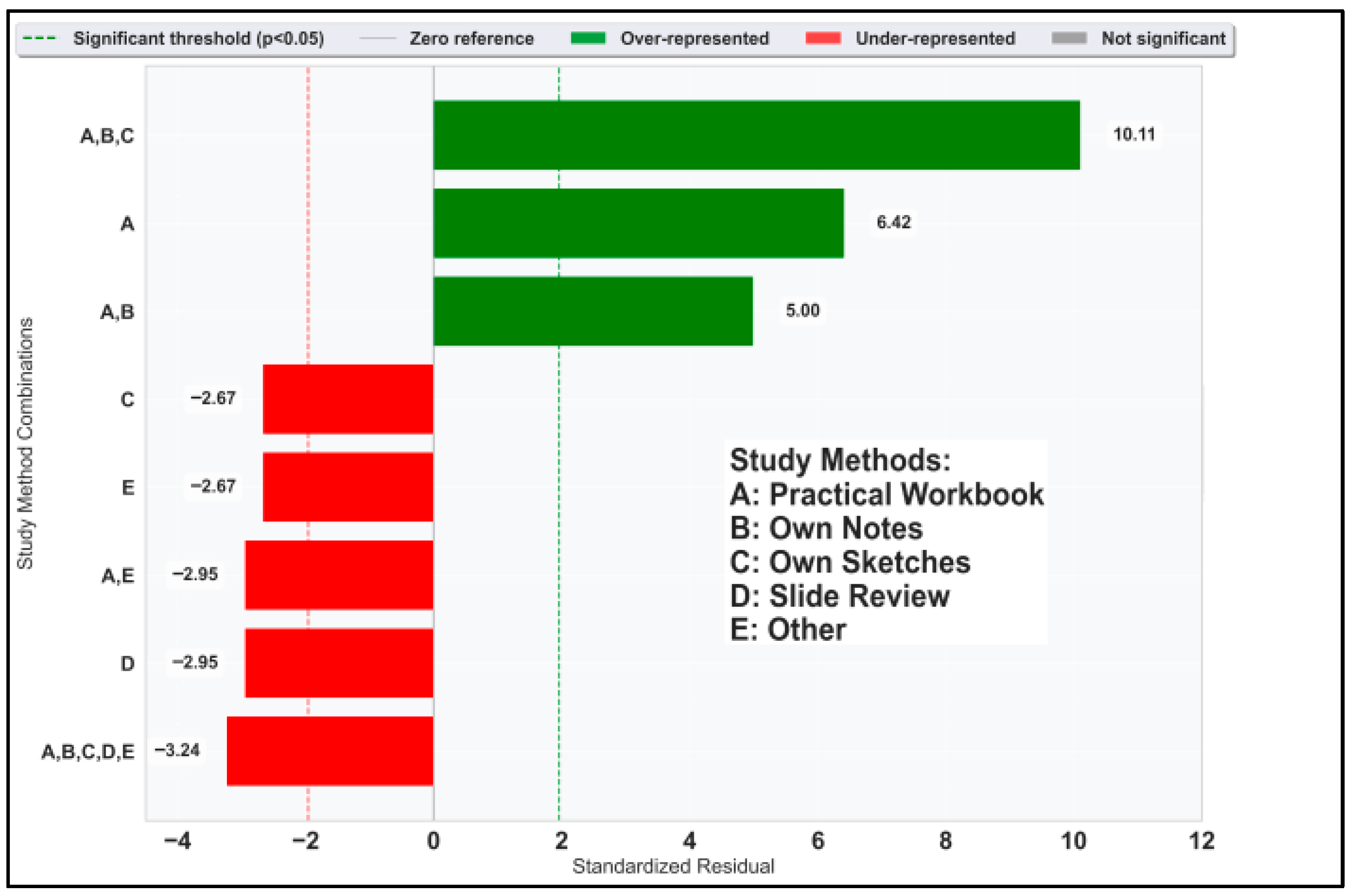
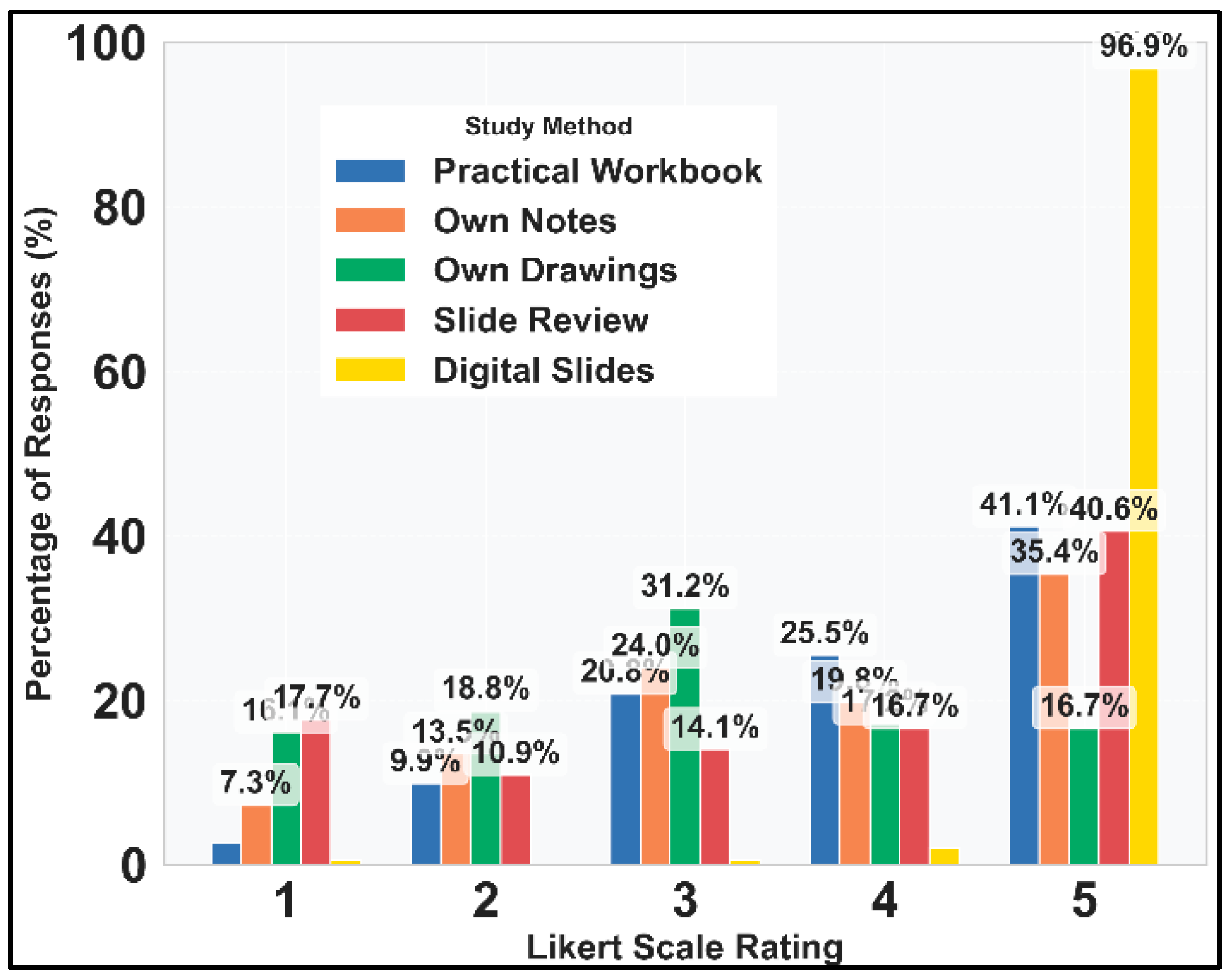
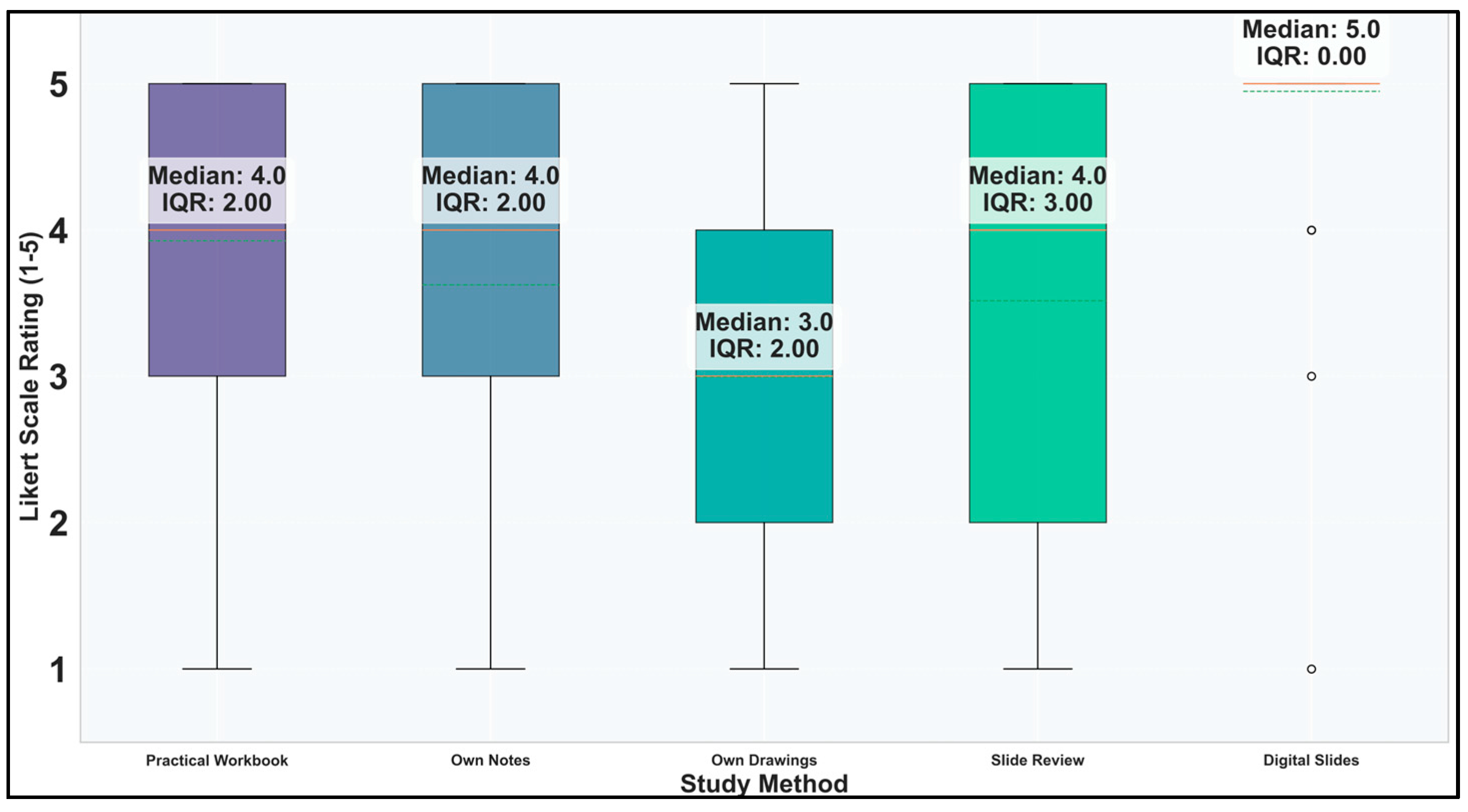
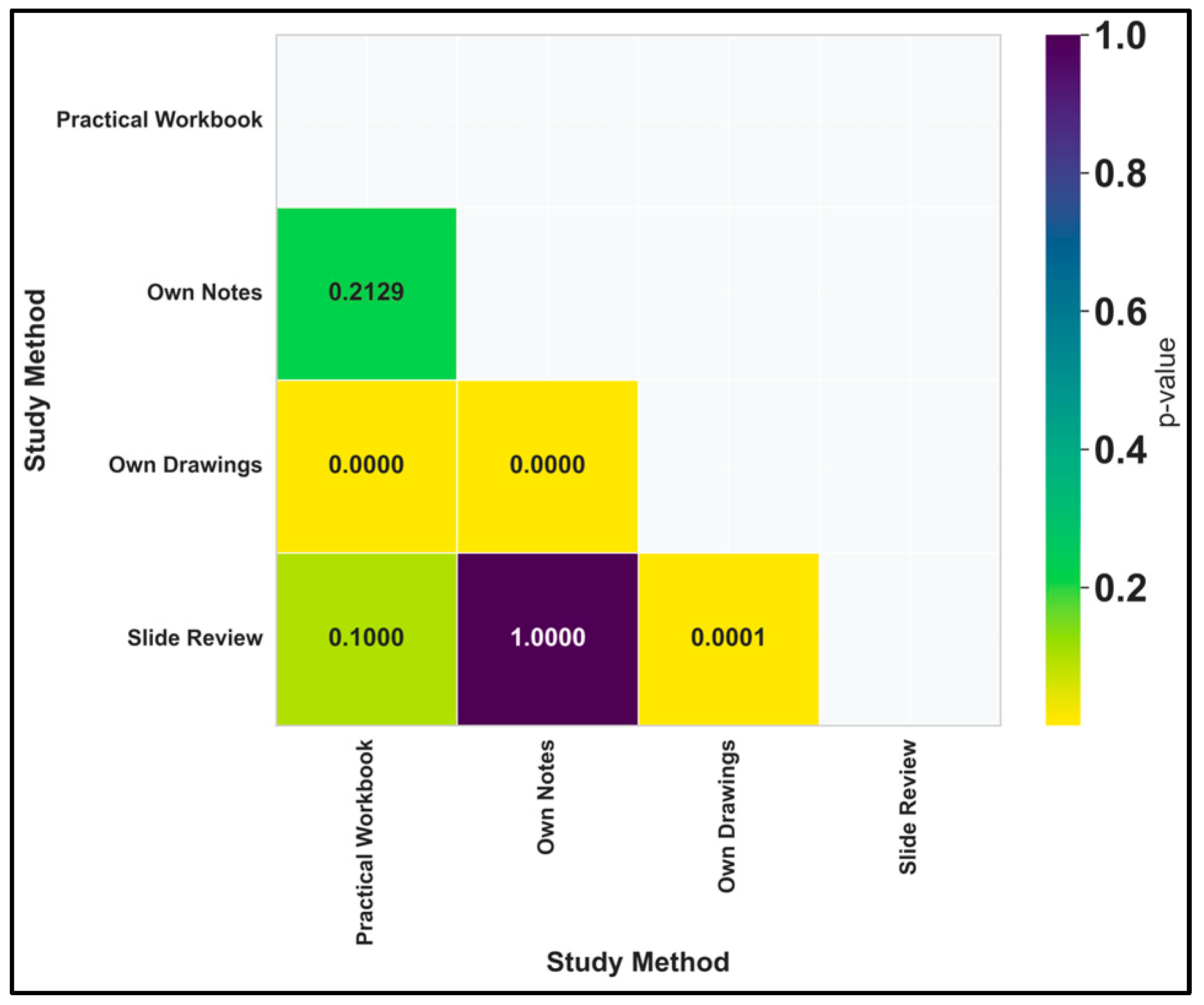
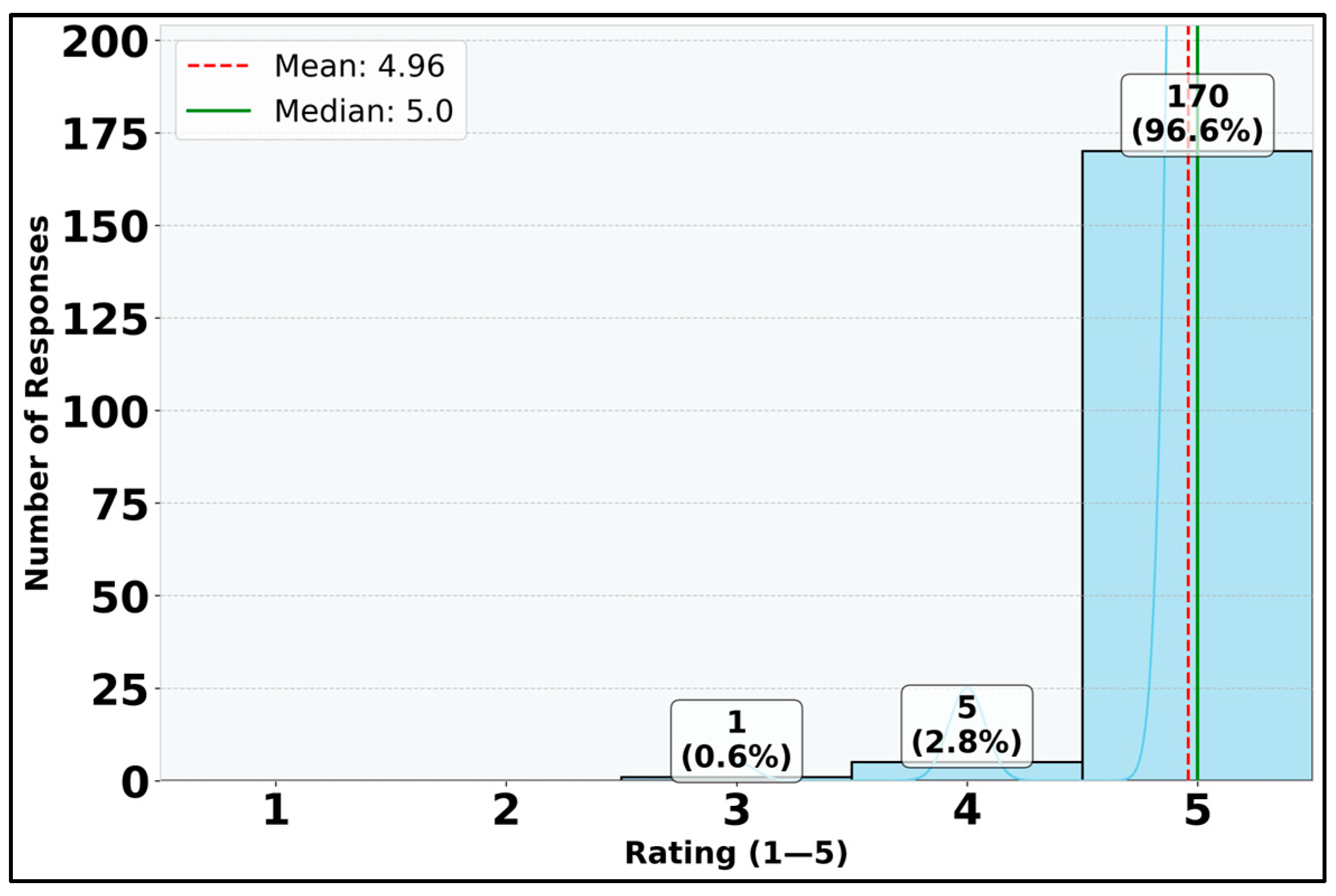
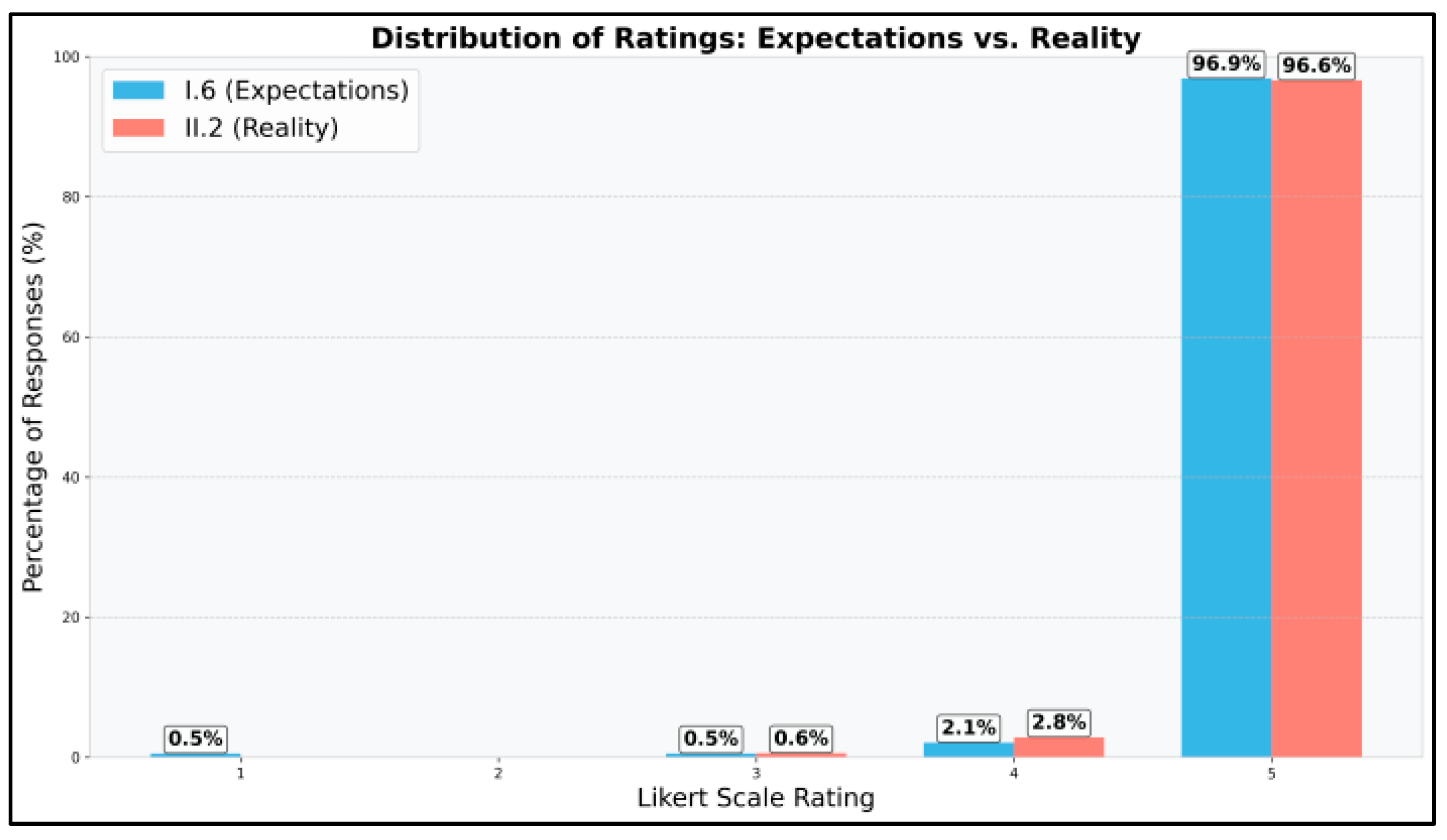
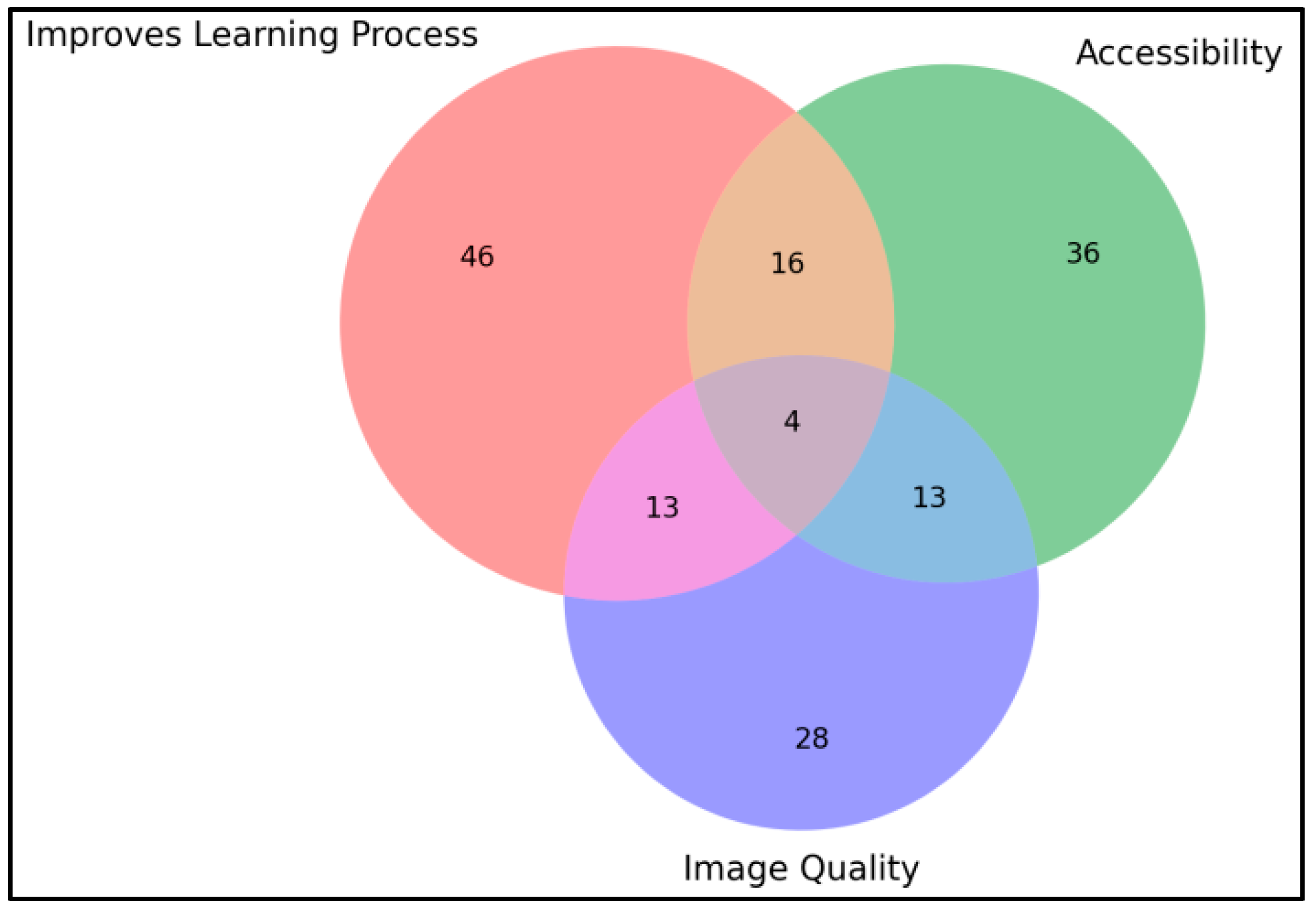
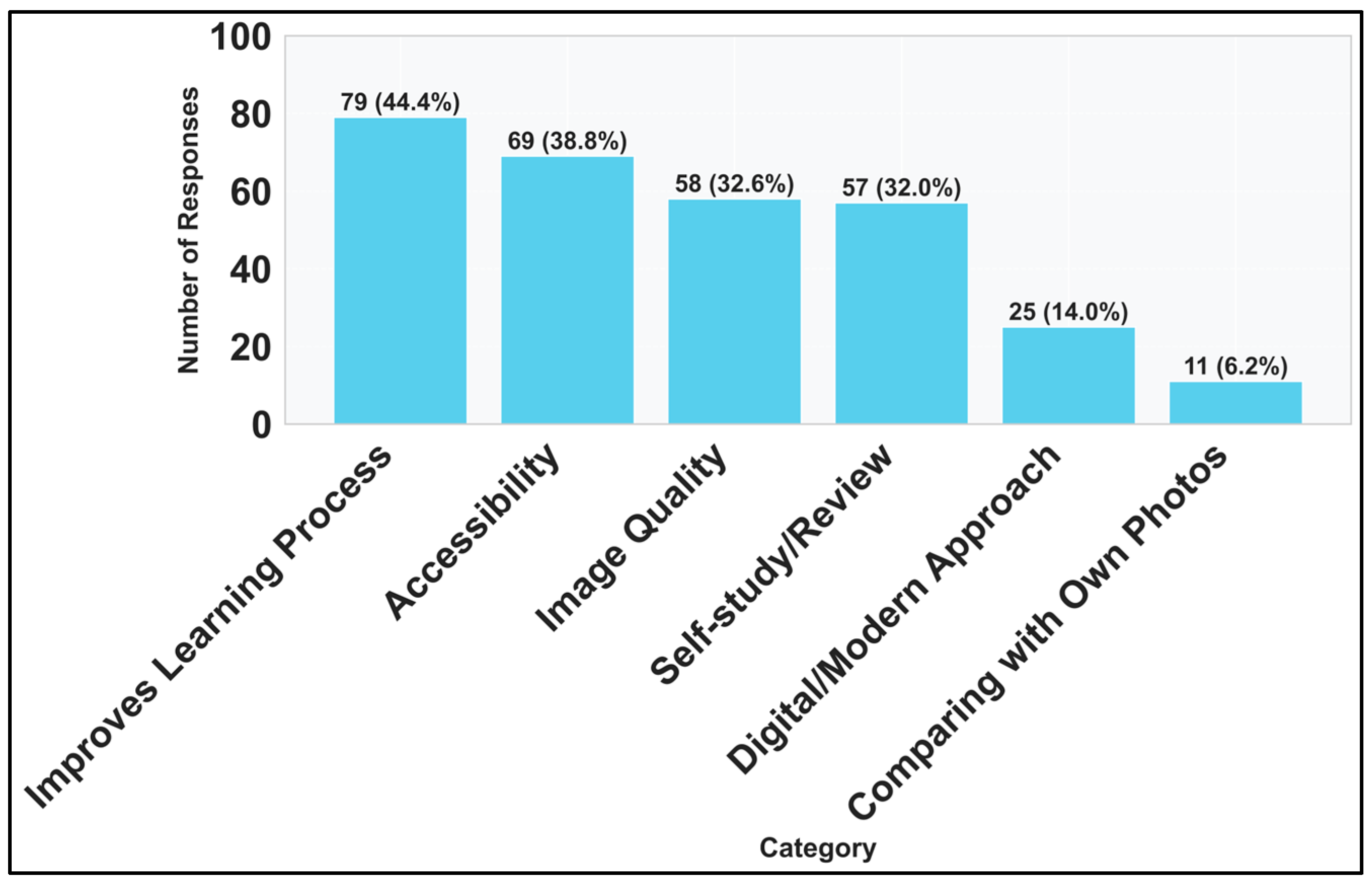
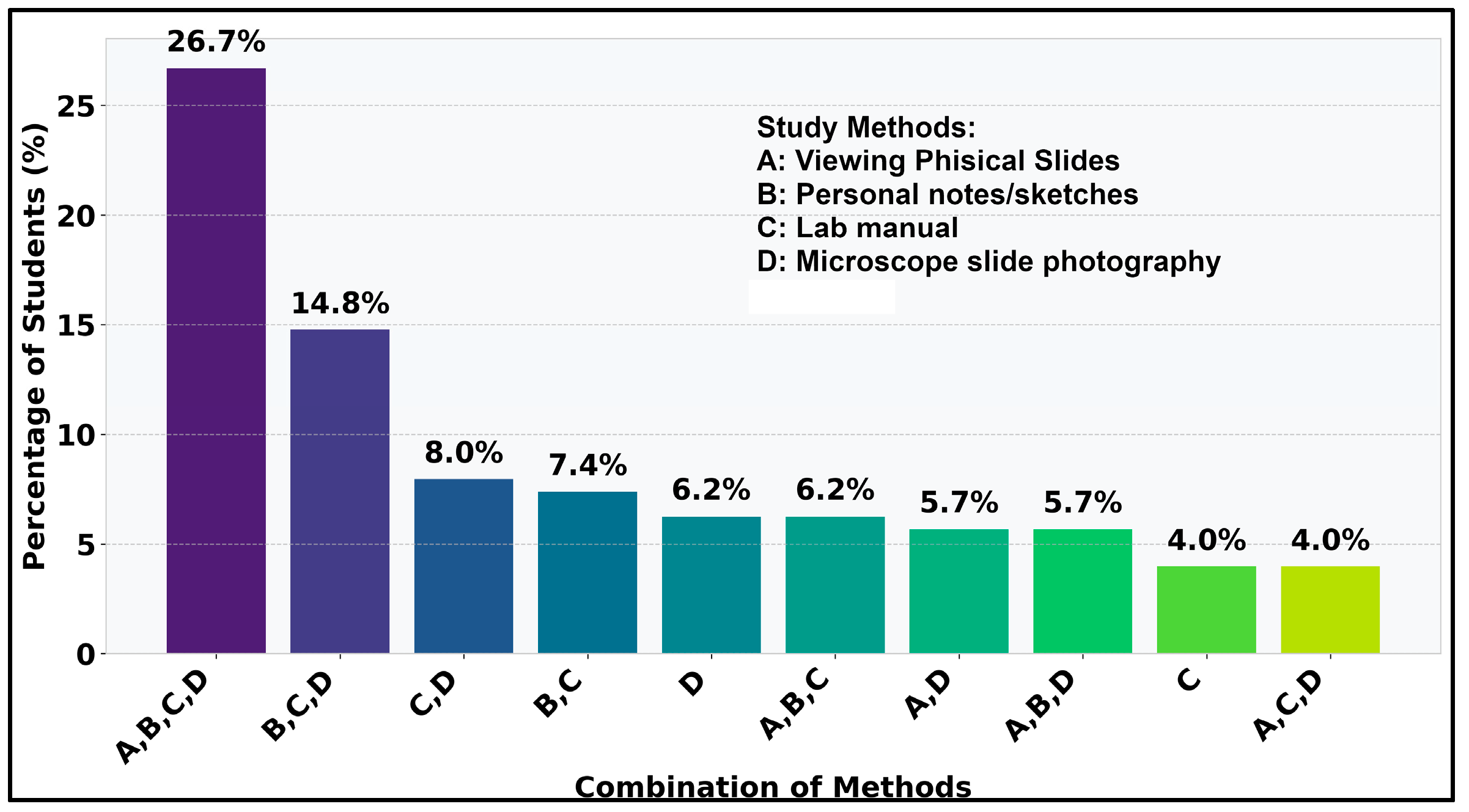
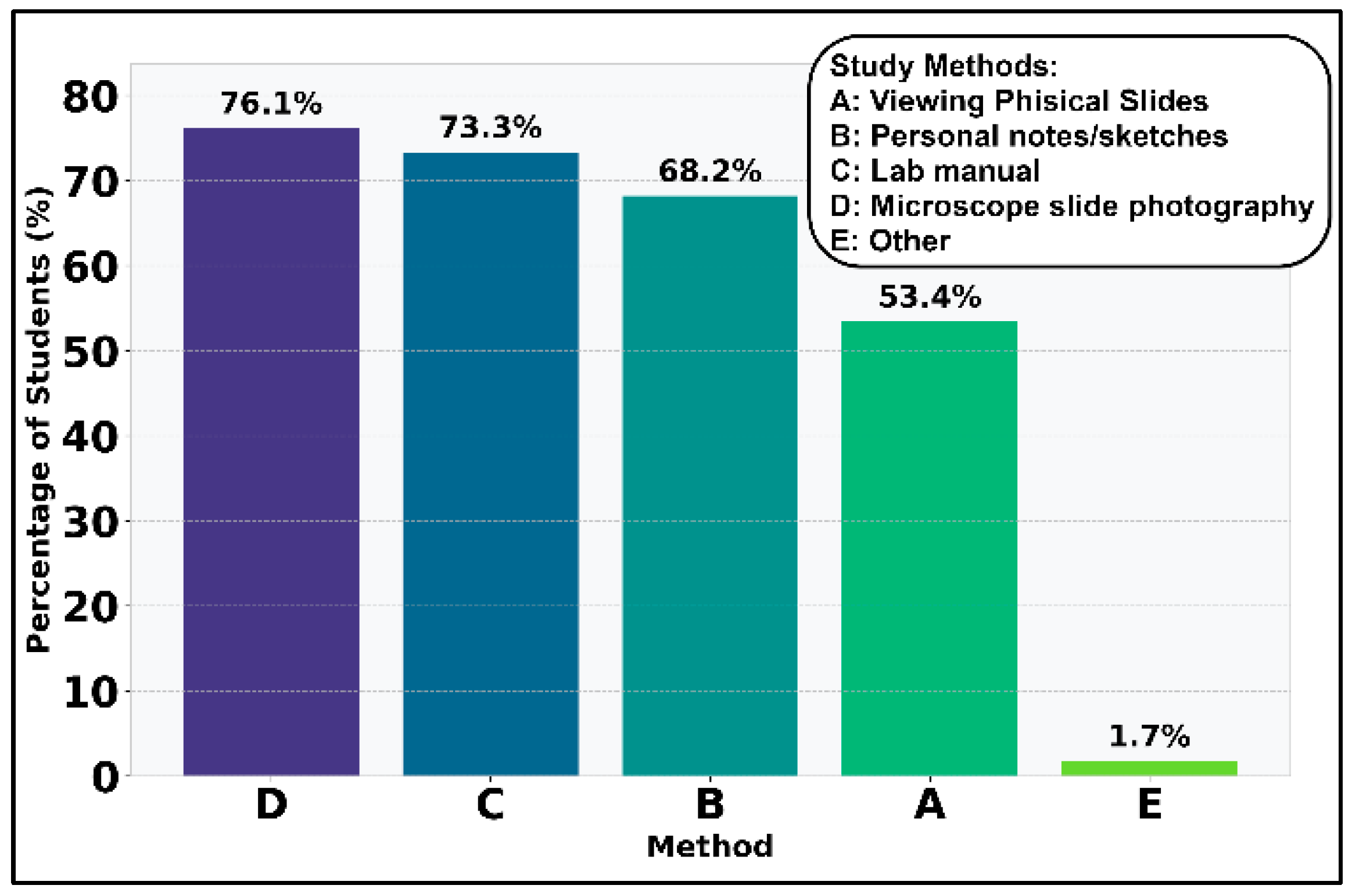
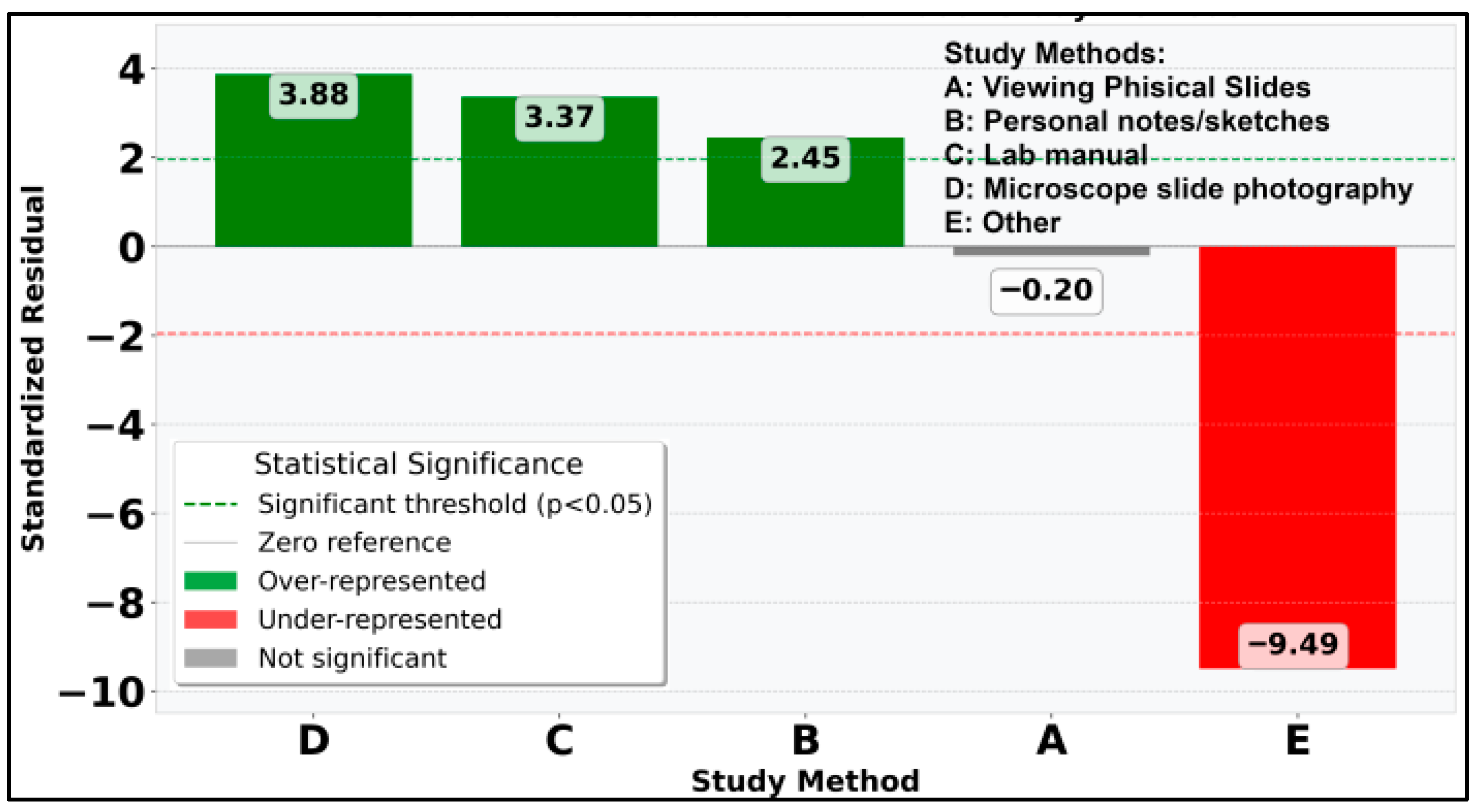
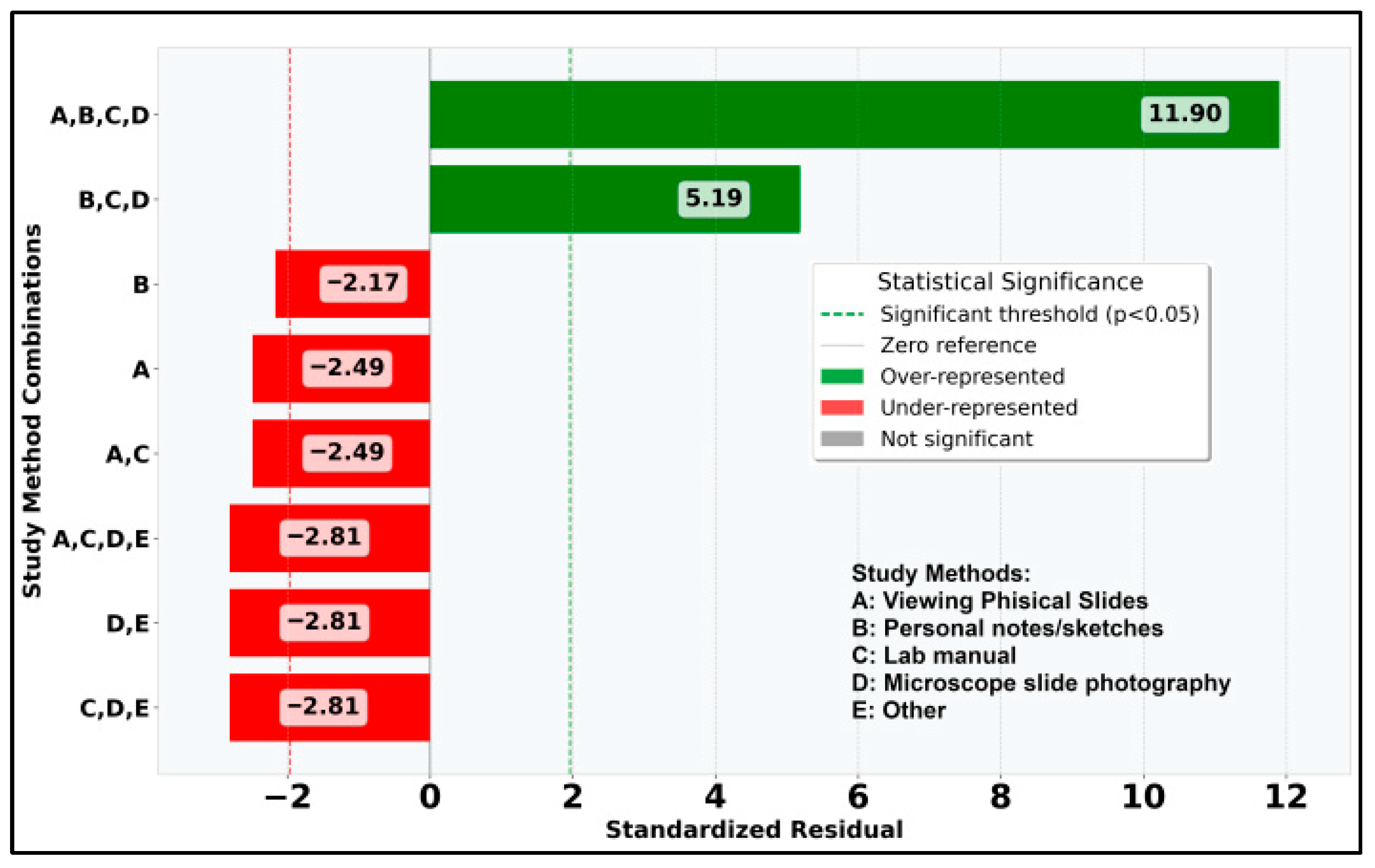
| Identifier | Question (EN) | Type |
|---|---|---|
| I.1 | What methods do you use to prepare for the histopathology test? | Multiple Choice |
| I.2 | To what extent is the practical workbook useful and do you use it to prepare for the histopathology test? | Likert Scale |
| I.3 | To what extent are your own notes useful and do you use them to prepare for the histopathology test? | Likert Scale |
| I.4 | To what extent are your own sketches useful and do you use them to prepare for the histopathology test? | Likert Scale |
| I.5 | To what extent is it useful and do you use off-schedule slide review under the microscope in the lab for histopathology test preparation? | Likert Scale |
| I.6 | How useful would it be to have scanned and digitally available histopathology slides? | Likert Scale |
| Identifier | Option (EN) | Option—Short |
|---|---|---|
| A | Learning from the practical workbook | Practical Workbook |
| B | Reading the notes taken during the laboratory | Own Notes |
| C | Learning with own laboratory sketches | Own Sketches |
| D | Coming to look at slides outside the program | Slide Review |
| E | Other (free-text response) | Other |
| Identifier | Question (EN) | Type |
|---|---|---|
| II.1 | Have you accessed the platform for viewing digital slides? | Dichotomous |
| II.2 | How useful do you think the platform was, on a scale of 1 to 5? | Likert Scale |
| II.3 | What are the positive aspects of the platform? (Why do you think it is good?) | Open-Ended |
| II.4 | How do you think the platform could be improved? | Open-Ended |
| II.5 | Besides the digital platform, what other methods did you use to prepare for the practical histopathology test? (Select all applicable options) | Multiple Choice |
| Identifier | Option (EN) | Option—Short |
|---|---|---|
| A | Viewing physical slides in the laboratory | Viewing Slides |
| B | Personal notes/sketches | Own Notes |
| C | Lab manual | Lab Manual |
| D | Microscope slide photography | Slide Photo |
| E | Other (free-text response) | Other |
| Category | Count | Representative Concepts |
|---|---|---|
| Generally, improves the learning process | 79 | Helps or improves study |
| It’s easy to use/best accessibility/more time to study | 69 | Easy/easier to learn, accessible, time, efficiency |
| Praising the zoom capability/Image quality | 58 | Clear pictures, zoom, picture quality |
| Highlighting the improvement on self-study/helps reviewing knowledge | 57 | Specifically mentioning self-study and/or reviewing knowledge |
| Highlighting the digital aspect and its benefits/It’s a modern study method | 25 | Modern, digital |
| Comparing digital slides with own microscope photos | 11 | Microscope photos, comparison, digital slides |
| No answer | 4 | Filler characters and/or spaces only |
Disclaimer/Publisher’s Note: The statements, opinions and data contained in all publications are solely those of the individual author(s) and contributor(s) and not of MDPI and/or the editor(s). MDPI and/or the editor(s) disclaim responsibility for any injury to people or property resulting from any ideas, methods, instructions or products referred to in the content. |
© 2025 by the authors. Licensee MDPI, Basel, Switzerland. This article is an open access article distributed under the terms and conditions of the Creative Commons Attribution (CC BY) license (https://creativecommons.org/licenses/by/4.0/).
Share and Cite
Fuerea, B.G.; Rizac, R.I.; Botez, A.R.; Militaru, M. Developing and Evaluating a Digital Pathology Platform for Veterinary Students: A Case Study in Romania. Vet. Sci. 2025, 12, 769. https://doi.org/10.3390/vetsci12080769
Fuerea BG, Rizac RI, Botez AR, Militaru M. Developing and Evaluating a Digital Pathology Platform for Veterinary Students: A Case Study in Romania. Veterinary Sciences. 2025; 12(8):769. https://doi.org/10.3390/vetsci12080769
Chicago/Turabian StyleFuerea, Bogdan Gabriel, Raluca Ioana Rizac, Andrei Robert Botez, and Manuella Militaru. 2025. "Developing and Evaluating a Digital Pathology Platform for Veterinary Students: A Case Study in Romania" Veterinary Sciences 12, no. 8: 769. https://doi.org/10.3390/vetsci12080769
APA StyleFuerea, B. G., Rizac, R. I., Botez, A. R., & Militaru, M. (2025). Developing and Evaluating a Digital Pathology Platform for Veterinary Students: A Case Study in Romania. Veterinary Sciences, 12(8), 769. https://doi.org/10.3390/vetsci12080769







